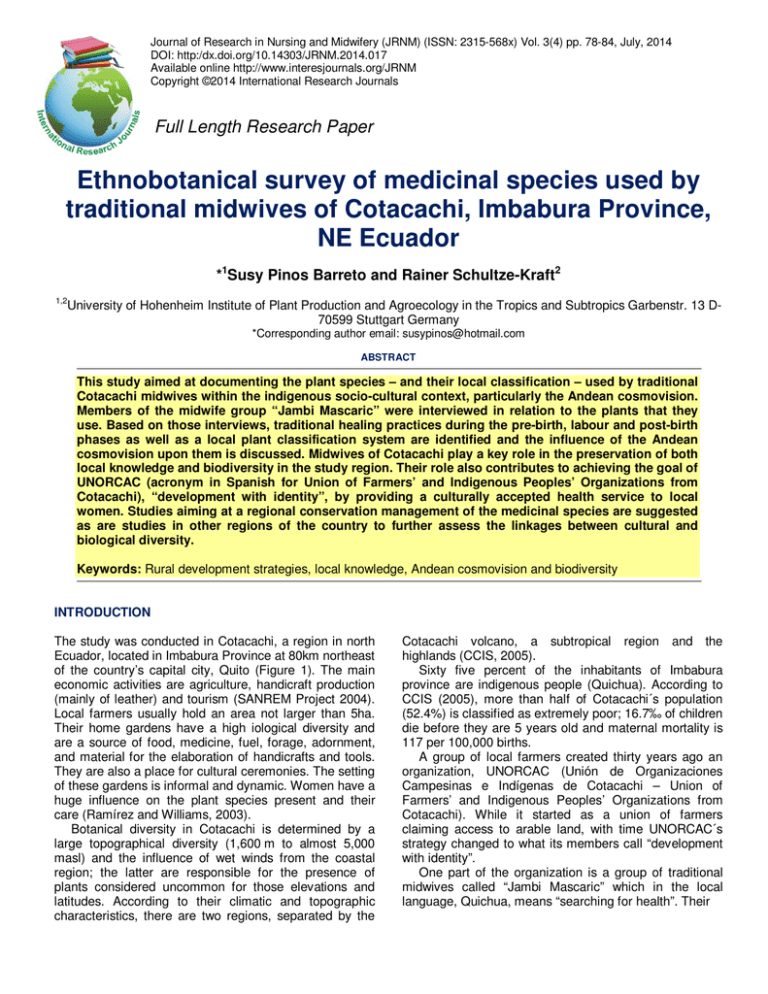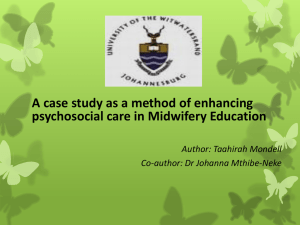Document 14249282
advertisement

Journal of Research in Nursing and Midwifery (JRNM) (ISSN: 2315-568x) Vol. 3(4) pp. 78-84, July, 2014 DOI: http:/dx.doi.org/10.14303/JRNM.2014.017 Available online http://www.interesjournals.org/JRNM Copyright ©2014 International Research Journals Full Length Research Paper Ethnobotanical survey of medicinal species used by traditional midwives of Cotacachi, Imbabura Province, NE Ecuador *1Susy Pinos Barreto and Rainer Schultze-Kraft2 1,2 University of Hohenheim Institute of Plant Production and Agroecology in the Tropics and Subtropics Garbenstr. 13 D70599 Stuttgart Germany *Corresponding author email: susypinos@hotmail.com ABSTRACT This study aimed at documenting the plant species – and their local classification – used by traditional Cotacachi midwives within the indigenous socio-cultural context, particularly the Andean cosmovision. Members of the midwife group “Jambi Mascaric” were interviewed in relation to the plants that they use. Based on those interviews, traditional healing practices during the pre-birth, labour and post-birth phases as well as a local plant classification system are identified and the influence of the Andean cosmovision upon them is discussed. Midwives of Cotacachi play a key role in the preservation of both local knowledge and biodiversity in the study region. Their role also contributes to achieving the goal of UNORCAC (acronym in Spanish for Union of Farmers’ and Indigenous Peoples’ Organizations from Cotacachi), “development with identity”, by providing a culturally accepted health service to local women. Studies aiming at a regional conservation management of the medicinal species are suggested as are studies in other regions of the country to further assess the linkages between cultural and biological diversity. Keywords: Rural development strategies, local knowledge, Andean cosmovision and biodiversity INTRODUCTION The study was conducted in Cotacachi, a region in north Ecuador, located in Imbabura Province at 80km northeast of the country’s capital city, Quito (Figure 1). The main economic activities are agriculture, handicraft production (mainly of leather) and tourism (SANREM Project 2004). Local farmers usually hold an area not larger than 5ha. Their home gardens have a high iological diversity and are a source of food, medicine, fuel, forage, adornment, and material for the elaboration of handicrafts and tools. They are also a place for cultural ceremonies. The setting of these gardens is informal and dynamic. Women have a huge influence on the plant species present and their care (Ramírez and Williams, 2003). Botanical diversity in Cotacachi is determined by a large topographical diversity (1,600 m to almost 5,000 masl) and the influence of wet winds from the coastal region; the latter are responsible for the presence of plants considered uncommon for those elevations and latitudes. According to their climatic and topographic characteristics, there are two regions, separated by the Cotacachi volcano, a subtropical region and the highlands (CCIS, 2005). Sixty five percent of the inhabitants of Imbabura province are indigenous people (Quichua). According to CCIS (2005), more than half of Cotacachi´s population (52.4%) is classified as extremely poor; 16.7‰ of children die before they are 5 years old and maternal mortality is 117 per 100,000 births. A group of local farmers created thirty years ago an organization, UNORCAC (Unión de Organizaciones Campesinas e Indígenas de Cotacachi – Union of Farmers’ and Indigenous Peoples’ Organizations from Cotacachi). While it started as a union of farmers claiming access to arable land, with time UNORCAC´s strategy changed to what its members call “development with identity”. One part of the organization is a group of traditional midwives called “Jambi Mascaric” which in the local language, Quichua, means “searching for health”. Their Barreto and Schultze-Kraft 79 Fig. 1. Map of Ecuador with the study region main task is to help local women to deliver their babies, but they also provide pre- and post-natal care. The services of such “mama ullca” (midwives in Quichua) are free of formal charge and since there are not enough medical doctors in the area, their role strengthens the local support network of indigenous people. Since in regions with indigenous communities biological and cultural diversity are complementary phenomena (Warren, 1992), the aim of this study was not only to document the plant species used by traditional Cotacachi midwives but also to describe the role of their traditional healing practices, plant uses and plant classification in the indigenous socio-cultural context, particularly the Andean cosmovision. Methodological approach During March to May 2006, 5 traditional midwives in an equal number of rural communities of the Andean sector (highlands) in Cotacachi (La Calera, Perafán, San Pedro, Quitumbo Alto and Turuco) were interviewed. In general, interviews consisted of 2-3 visits and were complemented by seeking confirmation and additional information from herb sellers at local markets. Interviews were recorded and transcribed on the same day of the visit. An interview guideline was used to cover the following topics: • Personal history of the midwife: Essentially, why she became a midwife and how she learnt about the traditional healing practices. • Medicinal plants that she uses: Which plant is used for which condition; forms of preparation and administration. • Agroecological information about the medicinal plants: Usually the main interview was carried out during a walk around the midwife’s home or in her home garden. This allowed to collect plant samples and to make observations on the growth environment. (It also could help the midwife’s memory because during the walk she might come across species that she would have forgotten in the previous interview). A set of cards with pictures of some plant species was used during the interviews as a tool to increase the understanding of the local plant classification system and its most important characteristics from the midwives’ point of view by sorting them. This method consists of requesting the interviewee to cluster the species depicted on the cards in different groups (Nazarea et al., 2003). Each group would be named according to the selection criteria used by the interviewee and would thus reveal the 80 J. Res. Nurs. Midwifery Table 1. Commonly used plant species during pre-birth Scientific name Local name* Medicinal purpose Baccharis fuliginea Kunth Coriandrum sativum L. Annona cherimola Mill. Ricinus communis L. Carica microcarpa Jacq. chilca blanca (S) to eliminate “inner cold” and speed up birth to eliminate “inner cold” and speed up birth to eliminate “inner cold” and speed up birth to reduce pain in hip bone to eliminate “inner cold” and speed up birth culantro (S) chirimolla (S) higuerilla blanca (S), yurac quiquirilla (Q) chihualcán (S,Q) Parts used leaves Preparation Administration Infusion oral, when labour pains start seeds Infusion oral, when labour pains start old leaves leaves Infusion oral; also in a combined infusion with other plants put around the woman´s womb the night before childbirth oral leaves leaves are heated Infusion *S: Spanish, Q: Quichua basis of the midwives’ local classification system. During the complementary interviews of herb sellers – in our study also considered key persons – at local markets of Ibarra, Otavalo and Cotacachi, the cards were also used in order to confirm the information obtained from the midwives. Some differences were found and required follow-up interviews. Such data triangulation methods are use in social science with the objectives of data confirmation and completion by using multiple data sources and methods to cross-check and validate findings (Begley, 1996). To create a voucher herbarium, procedures as described by Miller and Nyberg (1995) were followed. Specimens were sent to the National Herbarium of Ecuador, Quito, for species identification. RESULTS AND DISCUSSION Different approaches to diversity During the interviews it was possible to notice the interdependency between the local knowledge held by midwives and their utilization of plants. In order to gain a better understanding of these interactions, an overview of the Andean cosmovision is required. Community values, practices and belief systems are part of what is called “cosmovision”; it affects the diverse ways of understanding natural, spiritual and social interactions in local indigenous communities. The Andean perspective, or Andean cosmovision, consists of perceiving that the cosmos is alive: Quichuas do not divide the world into living and inert beings (Sperandeo, 2001). Based on that, biological diversity is not seen simply as a relationship between humans and nature, but deities and spirits are included too. According to Quichuas, the relationship between humans and nature is reciprocal and mutual. Like for the Asian cosmovision (Yunnan Initiative, 2000), Earth is a deity, from whom permission is to be asked when one wants to cultivate. An important aspect of the Andean cosmovision is that of duality: Two contrary forces interact to keep the natural equilibrium such as the human’s inner equilibrium (health). Consequently, healing practices of traditional midwives are an expression of that cosmovision, since their practices are meant to re-establish the inner equilibrium whose disturbance caused the condition. In contrast with a superficial impression an outsider might get, traditional midwives do have a quite significant place in the social context of an Andean community: In the Andean society, there is a close relation between generosity and hierarchy. It is a general belief that, in order to survive, an individual should be part of a social system of mutual (reciprocal) obligations (Sperandeo, 2001). By helping other women, the midwife is showing her superiority – based on the knowledge that she has – but also her generosity, because of that the woman she assists and her family are in debt with her. By doing so, the midwife ensures her belonging to that social system of mutual obligations where she is committed to assist the woman that asks for her help, and the mother and her family are committed to reciprocate. Usually the midwife is rewarded with some food or money according to the willingness of the mother and her family. But what really matters is that she gains social acceptance, recognition, respect and future favors. Midwifery: Traditional medicinal plants healing practices and All healing practices of a midwife are based on her own experience, since it is on the basis of their own pregnancies that midwives got a better insight into the symptoms and effects of the different healing practices and herbal medicines. Most of the traditional practices prior to birth are meant to prepare the baby and the mother so that future difficulties could be avoided. Table 1 presents the plant species most commonly used during the pre-birth phase. A special ritual is held at the beginning of delivery: The midwife would tear into pieces a white fabric sheet above Barreto and Schultze-Kraft 81 Table 2. Commonly used plant species during birth Scientific name Canna edulis Ker Gawl. Carica microcarpa Jacq. Annona cherimola Mill. Chenopodium ambrosioides L. Local name* achira (S), atsera (Q) chihualcán (S,Q) chirimolla (S) paico (S,Q) Medicinal purpose to break “inner cloak” (placenta) to break “inner cloak” (placenta) to give strength to mother to give strength to mother Parts used young, unfolded leaves leaves Preparation --- seeds infusion Administration leaves are torn into pieces on the mother’s womb leaves are torn into pieces on the mother’s womb oral, during labour leaves infusion oral, during labour --- *S: Spanish, Q: Quichua Table 3. Commonly used plant species during post-birth Desmodium intortum (Mill.) Urb. higo (S) jimbogata (S,Q) chilca negra (S), pinzi (Q) paico (S,Q) hierba mora (S), filimuyo (Q) marco (S), marco yura (Q) (1) leaves (2) buds (1) roots and leaves (2) roots leaves to stop bleeding after labour to stop bleeding after labour to prevent infection to prevent infection roots leaves leaves to prevent infection leaves to prevent infection leaves leaves Preparation Administration infusion oral infusion oral (1,2) infusion (1,2) oral (2) infusion (1) direct contact with skin (2) oral infusion bath oral culantro de montaña/ de pozo (S) mosquera (S,Q) matico (S,Q) (1) to increase milk production (2) to reduce uterus size (1) to join hip bones (“encaderar”) (2) to reduce uterus size first bath of baby Parts used leaves and flowers tuber infusion with four species Baccharis polyantha Kunth Chenopodium ambrosioides L. Adiantum aethiopicum L. Croton tiglium L. Eupatorium glutinosum Lam. Solanum americanum Mill. Franseria artemisioides Willd. camote (S) Medicinal purpose to calm the mother’s nerves after labour to increase milk production oral Ficus carica L. Local name* atacu (S,Q) infusio n with both species Scientific name Amaranthus caudatus L. Ipomoea batatas (L.) Lam. *S: Spanish, Q: Quichua the woman’s womb, or a newspaper sheet, or the youngest, still unfolded leaf of Canna edulis Ker Gawl., in order to break the “inner cloak” (placenta) that surrounds the baby. After doing so, delivery is supposed to be easier and less painful. During labour, the midwife’s duty is to receive the child but also to help the mother not to lose her strength which could be mortal for both. To give the mother more strength, the midwife prepares infusions from different plants (Table 2). She also cuts the cord, checks that the placenta came out properly, and wraps the baby. In case of any emergency, the midwives of “Jambi Mascaric” are trained to refer the mothers to the local hospital. After delivery, the midwife is supposed to visit the new mother and her child once a week or every second week, according to the situation. During these visits, she would check if the baby’s belly is going well and if the mother is eating properly. But their most important task is to “encaderar” (in Spanish), which means to join together the mother’s hip bones and help the uterus to recover its original size and place. During these sessions, advice is given to the mother how to increase milk production, bath the baby and apply vaginal baths to avoid infections or irritation. Again, a number of plant species is used for these purposes (Table 3). Regarding the main plant species used there were no large differences among the communities (Table 4), maybe because the kind of knowledge that the midwives have is very condition and disease specific; thus the number of plant species used seems to be limited. These species, some of them wild, some domesticated, occur on fallow land, ditches, ravines, in secondary forests and 82 J. Res. Nurs. Midwifery Table 4. Main medicinal plant species used in the different communities Plant family and species Amaranthaceae Amaranthus caudatus L. Annonaceae Annona cherimola Mill. Apiaceae Coriandrum sativum L. Asteraceae Baccharis polyantha Kunth Baccharis fuliginea Kunth Papaver sp. Eupatorium glutinosum Lam. Franseria artemisioides Willd. Cannaceae Canna edulis Ker Gawl. Caricaceae Carica microcarpa Jacq. Chenopodiaceae Chenopodium ambrosioides L. Convolvulaceae Ipomoea batatas (L.) Lam. Equisetaceae Equisetum bogotense Kunth Equisetum arvense L. Euphorbiaceae Ricinus communis L. Croton tiglium L. Fabaceae Desmodium intortum (Mill.) Urb. Linaceae Linum usitatissimum L. Moraceae Ficus carica L. Pteridaceae Adiantum aethiopicum L. Solanaceae Cestrum macrophyllum Vent. Solanum americanum Mill. Quitumbo Alto Perafán Turuco San Pedro La Calera X - - 0 0 X X - X X X - - X X X X 0 X X 0 X X X X - X 0 X X X X X X X X X X X - - - X 0 X - - - X - 0 X 0 0 0 X - - - X - X X X X X X - X X X X X - X X X X X - 0 X X X - X 0 X - - X 0 X X - X X X X X: species is used, 0: species is not used, -: no answer surrounding mountains. Although some plants used by midwives are sold in the local markets, usually women that live in rural areas collect them around their homes. The main differences between the sites where the plants grow seem to be related to land use rather than to climatic factors since in four of the five communities ecological conditions are quite similar (1800-2000 masl, average temperatures 12-18 °C, precipitation 500-1000 mm/year with 4-8 dry months; (SANREM Project, 2004). Turuco is the only community located at 1000-1800 masl and with only 2-4 dry months. Such a relevance of land use and its changes for conservation of medicinal plants was also mentioned for rural communities in the Caribbean Basin where the conversion of local agriculture and forest ecosystems to other purposes had led to the loss of people’s local knowledge about medicinal plants and their interest in conserving them (Lagos-Witte, 2005). Understanding species the local classification of plant The interviews revealed that there is a local classification system according to which plants are considered as “cold” or “warm” (Table 5) and as “female” or “male”. These are, again, examples of the duality in the Andean cosmovision: of two contrary forces interacting to keep the natural equilibrium. The reason why most of the medicinal plants used by the midwives are categorized as “warm” is that one of their major tasks is to Barreto and Schultze-Kraft 83 Table 5. Local classification of some plant species with medicinal purposes, according to midwives of “Jambi Mascaric” Cold plants Adiantum aethiopicum Solanum americanum Equisetum bogotense Equisetum arvense Cestrum macrophyllum Warm plants Baccharis polyantha, B. fuliginea Coriandrum sativum, Carica microcarpa Chenopodium ambrosioides, Desmodium intortum Eupatorium glutinosum, Ricinus communis Franseria artemisioides, Ficus carica Annona cherimola, Ipomoea batatas counteract the inner “frío” (cold) that pregnant women could catch causing womb ache during pregnancy and labor. Based on the interviews and other sources such as Argüello and Sanhueza (1996), it can be inferred that: • Diseases classified as “cold” are treated with “warm” plants (or animals); “warm” diseases are treated with “cold” plants (or animals). • The classification of a plant (or animal) as “warm” and “cold” is related to its effect and not necessarily to external characteristics of the species. • Midwives in the region do not use animal species for their work but traditional healers in other regions of the country do. Regarding the local classification of a plant as “female” or “male”, no information that could explain the differentiating reasons for such perceptions was found in the literature. However, according to the interviews, a female plant would have longer leaves and longer internodes while male plants have broader leaves and are shorter. Plant species with a female or male partner often grow next to each other. Sometimes one of the partners belongs to a different species, sometimes to the same species but then with slight morphological differences. An example is the sympatric pair consisting of Baccharis fuliginea Kunth and Baccharis polyantha Kunth (“chilca blanca” and “chilca negra”, respectively), both “warm plants”, endemic bushes up to 1.5 m high that are to be found in cold climate, e.g. in the Ecological Reserve of Cotacachi-Cayapas (3250 masl). The former species is the “female” partner, with white flowers and green stems; the leaves are used against “frío” and to speed up labour. The latter species is the “male” partner, also with white flowers but with brown stems; the leaves are used for an infusion to bath babies. Not all species that were mentioned by the midwives form part of a male-female couple. It could not be established whether the reason was that there is just no other partner, or that the interviewees simply did not know. Anyhow, the duality in the traditional classification system of diseases as well as plants (and animals) is another example of the way local people from the Andean region express their identity. Contribution of midwives development strategy to UNORCAC´s Within the indigenous rights movements in Latin America that started to have an impact on community based development during the 90’s, indigenous communities especially in the Andes demanded from research and development programs that change agents should work within the needs of the community, not the needs as perceived by outsiders (donors or scientists). Indigenous leaders, with their emphasis on self-determination, claimed for a mature relationship with outside agencies and individuals, speaking of “equity without paternalism” and “development with identity” (Rhoades and Nazarea, 2006). Based on this rationale, community leaders grouped in UNORCAC established their development strategy based on the Andean cosmovision and its values. Accordingly, UNORCAC´s members formed “Jambi Mascaric”. However, not only midwives join this group, but they are its main and most respected members. Beyond health care as such – which is also particularly important because of deficiency of governmental medical services in remote areas like Cotacachi – the “Jambi Mascaric” midwives are holders of a special knowledge that allows them to provide women with health care that respects traditional values and perceptions. By recurring to underutilised medicinal plant species they promote their conservation. Thus the contribution of midwives to UNORCAC´s development strategy is not only related to the Andean cosmovision and the conservation of traditional values and indigenous knowledge but also to in-situ conservation of biodiversity. CONCLUSIONS If we agree that development in peripheral areas requires integrated strategies that recognize the links between culture, nature and livelihoods (Jianchu and Salas, 2003), it must be recognized that the role of midwives in their communities is of great importance for UNORCAC´s development strategy. Consequently, they are respected community members and play a key role in the conservation of the Andean culture by preserving the local knowledge related to traditional medicine. The research approach was flexible enough to allow exploring other aspects directly related to the context in which the medicinal plants are used. Ethical aspects do not regard only property right issues but are also related to the respect for the values, social interactions and diverse ways local people perceive their world 84 J. Res. Nurs. Midwifery (Cunningham, 2001). Because of this, the intrinsic value of those plants becomes apparent, and culturally acceptable conservation strategies can be designed. The interdependency of the plant species used by the midwives and their knowledge needs to be protected. For this, conservation is necessary to take into account those dynamic interactions to allow these processes to continue. This is only possible in the area where they actually happen. By encouraging midwives from “Jambi Mascaric” to continue practicing their traditional medicine and by giving them the chance to share their knowledge with other members of their community, a contribution to conservation of both local knowledge and biodiversity could be achieved. Further exchange with similar groups from other Andean regions could even increase the scope of plant (and animal) species to be conserved via utilization. UNORCAC’s strategy “development with identity” might have a good chance to lead to sustainable development (which sometimes seems to be so theoretical). As far as the contribution of “Jambi Mascaric” to this goal is concerned, two issues in particular should be encouraged: Firstly, training of the next generation of midwives in order to ensure intergenerational conservation of knowledge, and secondly, studies attempting a proper conservation management of the medicinal species. Most species are wild and grow in ruderal and agrestal habitats, and little or nothing at all is known about essentials such as their mode of reproduction, regional species distribution and population densities, and the impact of extraction by traditional healers. This study has provided some first, valuable information on medicinal plants and their use for traditional healing practices by an important ethnic group in the Ecuadorian highlands, however, restricted to a rather reduced region, Cotacachi. It is suggested to extend similar studies to further highland regions of the country in order to increase the understanding of the interdependency between a culturally important plant genetic resource and the Andean cosmovision, and to further assess the effect of land use changes on the availability and use of these plant genetic resources. ACKNOWLEDGEMENTS This work was supported by Vater and Sohn Eiselen Stiftung, Ulm, Germany. Thanks to UNORCAC´s members and the midwives of Jambi Mascaric for their support and collaboration. To Eiselen Foundation for the financial support that made this study possible. To Prof. Schultze-Kraft for his guidance and for being an example of professionalism and dedication. In Cotacachi to Francisca, Anita, Digna, Dolores, Blanca, Alicia, Rosita and all the women of “Jambi Mascaric”. Specially to Carmita Morán, Pamela Baez and Jorge Pazmiño, whose advices and sponsorship made my field-research more effective. REFERENCES Argüello S, Sanhueza R (1996). Medicina Tradicional Ecuatoriana. Banco Central del Ecuador, Instituto Otavaleño de Antropología. Ediciones Abya-Yala. Quito, Ecuador. Pp. 355. Begley C (1996). Using triangulation in nursing research. J. Advan. Nurs. 24(1): 122-128. Available at the web: http://www3.interscience.wiley.com/journal/119215692/abstract?CR ETRY=1&SRETRY=0 (Date of access: 11.11.2008). CCIS (Consejo Cantonal Intersectorial de Salud) (2005). Plan Cantonal de Salud de Cotacachi. Un Proyecto de Vida y Desarrollo Humano “Mushuk Ali Kawsaimanta”. Cotacachi, Ecuador. Pp. 130. Cunningham A (2001). Applied Ethnobotany. People, wild plant use and conservation. Earth scan Publ. Ltd. London, England. Pp. 300. Jianchu X, Salas M (2003). Moving the periphery to the center: indigenous people, culture and knowledge in a changing Yunnan. In: Kaosa-ard, M and Dore, J (Eds.), Social Challenges for the Mekong Region. White Lotus. Bangkok, Thailand. Pp. 123-145. Available at the web: http://www.rockmekong.org/pubs/Year2003/social/05_xu.PDF (Date of access: 10.12.2008). Lagos-Witte S (2006). Conservation of Medicinal Plants in Central America and the Caribbean. IK Notes No. 93 (June 2006). Available at the web: http://www.worldbank.org/afr/ik/iknt93.pdf (Date of access: 10.12.2008). Miller AG, Nyberg JA (1995). Collecting herbarium vouchers. In: Guarino L, Ramanatha Rao V, Reid R. (Eds.). Collecting Plant Genetic Diversity: Technical Guidelines. International Plant Genetic Resources Institute (IPGRI), Rome, Italy. Pp. 561-573. Nazarea V, Piniero M, Rhoades R, Alarcón R, Camacho J (2003). Costumbres del ayer, tesoros del mañana: Plantas de herencia, conocimientos ancestrales y bancos de memoria. Ediciones AbyaYala. Quito, Ecuador. Pp. 38. Ramírez M, Williams D (2003). Guía agro-culinaria de Cotacachi, Ecuador y Alrededores. International Plant Genetic Resources Institute (IPGRI-Americas). Cali, Colombia. Pp. 88. Rhoades R, Nazarea V (2006). Reconciling local and global agendas in sustainable development: Participatory research with indigenous Andean communities. J. Mountain Sci. 3(4): 334-346. SANREM Project (Proyecto Agricultura Sostenible y Manejo de los Recursos Naturales) (2004). El Cantón Cotacachi; Espacio y Sociedad; Investigación, Estadísticas y Mapas. Convenio de Cooperación entre Pontificia Universidad Católica del Ecuador y Universidad de Georgia. Ediguias C. Ltda. Quito, Ecuador. Pp. 82. Sperandeo S (2001). Claves para interpretar el mundo andino. Colibrí Ediciones. Lima, Perú. Pp. 396. Warren DM (1992). Indigenous knowledge, biodiversity conservation and development. Keynote address at the International Conference on Conservation of Biodiversity in Africa: Local Initiatives and Institutional Roles, 30 August-3 September 1992, Nairobi, Kenya. Available at the web: http://www.ciesin.org/docs/004-173/004173.html (Date of access: 10.12.2008). Yunnan Initiative (2000). Visions and Actions for the Enhancement of Biological and Cultural Diversity. Cultures and Biodiversity Congress 20-30 July 2000. Kunming, China. Pp. 42. Available at the web: http://www.bioculturaldiversity.net/Downloads/Papers/YunnanInitiative_English.pdf (Date of access: 10.12.2008). How to cite this article: Barreto S.P and Schultze-Kraft R. (2014). Ethnobotanical survey of medicinal species used by traditional midwives of Cotacachi, Imbabura Province, NE Ecuador. J. Res. Nurs. Midwifery 3(4):78-84


![Letter to MPs re: maternal mental health report Dear [Name of MP] I](http://s3.studylib.net/store/data/006839335_1-7d7b3127aade7ad6d126565942ce75c1-300x300.png)


